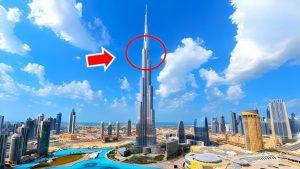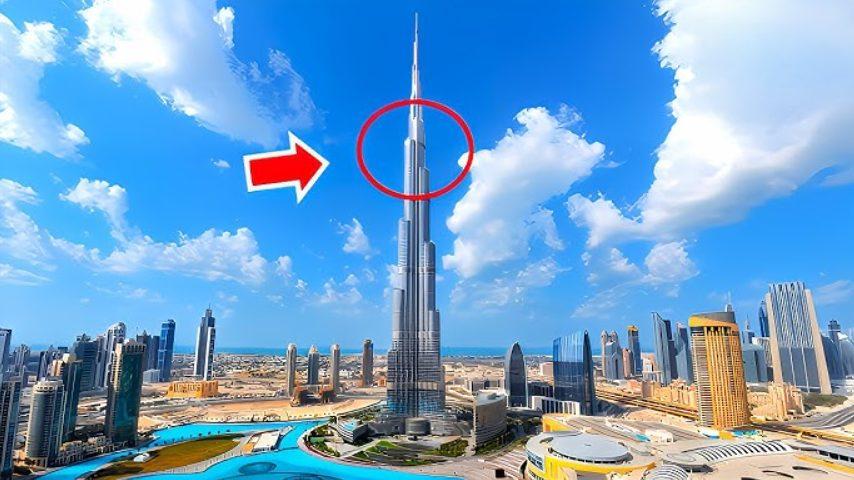I would like to take you on a tour of The Making of Burj Khalifa – The Iconic Tower in the World, the world’s tallest tower and a remarkable example of contemporary engineering. I still recall my initial impression of this magnificent building soaring above the skyline of Dubai. The idea that such a massive structure could be built in one of the world’s most extreme climates was astounding. Though it seems improbable at first, the idea has succeeded and is now a monument to human ingenuity, tenacity, and willpower.
The Vision: A Tower that Touches the Sky:
I was interested and dubious when I initially learned about the Burj Khalifa’s ambitions. Could it be a skyscraper that would reach the highest point not only in Dubai but the entire globe? It seemed like a fantasy, one that many believed would never materialize. However, in Dubai, the impossibly probable frequently becomes the reality.

The goal was crystal clear: to build a modern landmark that would establish Dubai as a center of luxury and innovation on a worldwide scale. In addition to its ambitious architectural design, the Burj Khalifa was intended to represent the boundless possibilities that arise when one has vision and perseverance.
Laying the Foundation: Building on Shifting Sands:
The Burj Khalifa’s location was the most intriguing component of its construction. I’ve always been curious in how such a large structure could be constructed on shifting desert sands. Modern engineering methods combined with unwavering human determination hold the key to the solution.
The Burj Khalifa’s foundation was constructed utilizing the deep pile method, which ensures stability. I discovered that a sturdy basis was constructed using more than 192 piles, each measuring 1.5 meters in diameter and reaching a depth of more than 50 meters. For this foundation, more than 45,000 cubic meters of concrete had to be placed carefully. The amount of thought and preparation that went into making sure the tower would remain stable on the shaky sands was astounding.
Also see: How to Grow a Real Estate Business in Dubai from Scratch
Engineering Marvel: Designing for Height and Heat:
Managing Dubai’s extreme heat and humidity was one of the most fascinating issues encountered during the construction of the Burj Khalifa. I used to wonder how the construction crew did their work in such terrible conditions.
The high temperatures presented serious difficulties for the building materials as well as the labor force. For example, to guarantee structural integrity, concrete must be poured and cured at particular temperatures. This method was far from simple in the intense heat of Dubai. Ice was added to the concrete mixture and it was poured at night to help reduce the heat’s impact. I seem to recall reading that they even tried a variety of concrete compositions to determine which one could endure the most intense climate.
Also see: Client Communication in Dubai Real Estate Cold Calling: My Personal Guide
Facing the Elements: Overcoming Weather Challenges:
There were particular weather-related difficulties in building the world’s tallest tower. The way the squad dealt with the intense summer heat, which frequently surpassed 45 degrees Celsius (113 degrees Fahrenheit), particularly captivated me. It took meticulous preparation and organization to work at such heights in the intense light.
The intense heat had an impact on every facet of the building. Extreme heat stress was experienced by the workers, and I was informed that safety and well-being precautions had been taken. To combat heat fatigue, water stations were placed across the site, regular breaks were required, and a rigid rotation plan was put in place.
Furthermore, the machinery and cranes were impacted by the extreme temperatures. I seem to recall reading that particular lubricants were utilized to keep the equipment from overheating. In order to keep the cranes operating effectively in spite of the heat, the team even devised a special cooling system for them.
Innovative Solutions: Adapting to the Climate:
An intriguing aspect of The Making of Burj Khalifa – The Iconic Tower in the World has always been the creative manner in which the harsh climate was accommodated. For instance, the tower’s outer cladding required a specific design to reduce energy usage and reflect solar heat. This cladding comprises more than 103,000 square meters of glass, 15,500 square meters of aluminum, and embossed stainless steel; the materials were carefully chosen to withstand the severe weather.
In order to lessen the temperature of the lower levels, the design also included a novel cooling system that utilized the cooler air at higher elevations. It fascinated me how every element of the structure, including its materials and shape, was meticulously chosen to ensure it could endure the most intense climate.
Constructing the Dream: Bringing the Vision to Life:
The Burj Khalifa had to be completed after the engineering difficulties were resolved and the foundation was put in place. More than 160 stories were built for this project, housing opulent residences, business buildings, hotels, and observation decks with breath-taking views of Dubai.
The 124th floor observation deck’s structure particularly astounded me. It sounded exciting and terrifying to be standing on a glass floor and gazing down at the city from such a height. One of the most recognizable aspects of the Burj Khalifa, the deck required cutting-edge technology and precision engineering to guarantee its stability and safety.
Overcoming Challenges: The Path to Success:
There were difficulties encountered during the Burj Khalifa construction process. The project encountered several challenges, including managing supply chain delays and overcoming strong winds at high altitudes. But each obstacle was overcome with creative answers and a commitment to realizing the goal.
Ensuring the safety of construction workers, particularly those operating at heights, was one of the main worries. I discovered that the group put in place a thorough safety program with training, drills, and routine inspections. Modern safety devices and harnesses were also utilized to safeguard the workers, demonstrating how important it was to prioritize safety throughout the building process.
Living the Dream: Burj Khalifa Today:
The Burj Khalifa is now a representation of Dubai’s aspirations and inventiveness. I’m in awe of what has been accomplished as I gaze up at this massive monument. The Burj Khalifa is more than simply a structure—it’s a work of art in contemporary architecture, an icon of luxury, and an example of human ingenuity.
The Burj Khalifa offers an experience unlike any other, whether you’re dining at the highest restaurant in the world, sleeping in a luxurious suite with unmatched views, or just taking in the amazing skyline from one of the observation decks.
The Legacy: A Monument to Human Achievement:
I’m reminded of the strength of vision, tenacity, and creativity when I think back on The Building of Burj Khalifa: The Most Iconic Tower in the World. It has become feasible to achieve what was previously thought to be impossible, encouraging us all to aim high and dream big.
More than just a tower, the Burj Khalifa is a representation of what is possible when we push the envelope. It serves as both a lighthouse of hope for coming generations and a monument to human progress.





